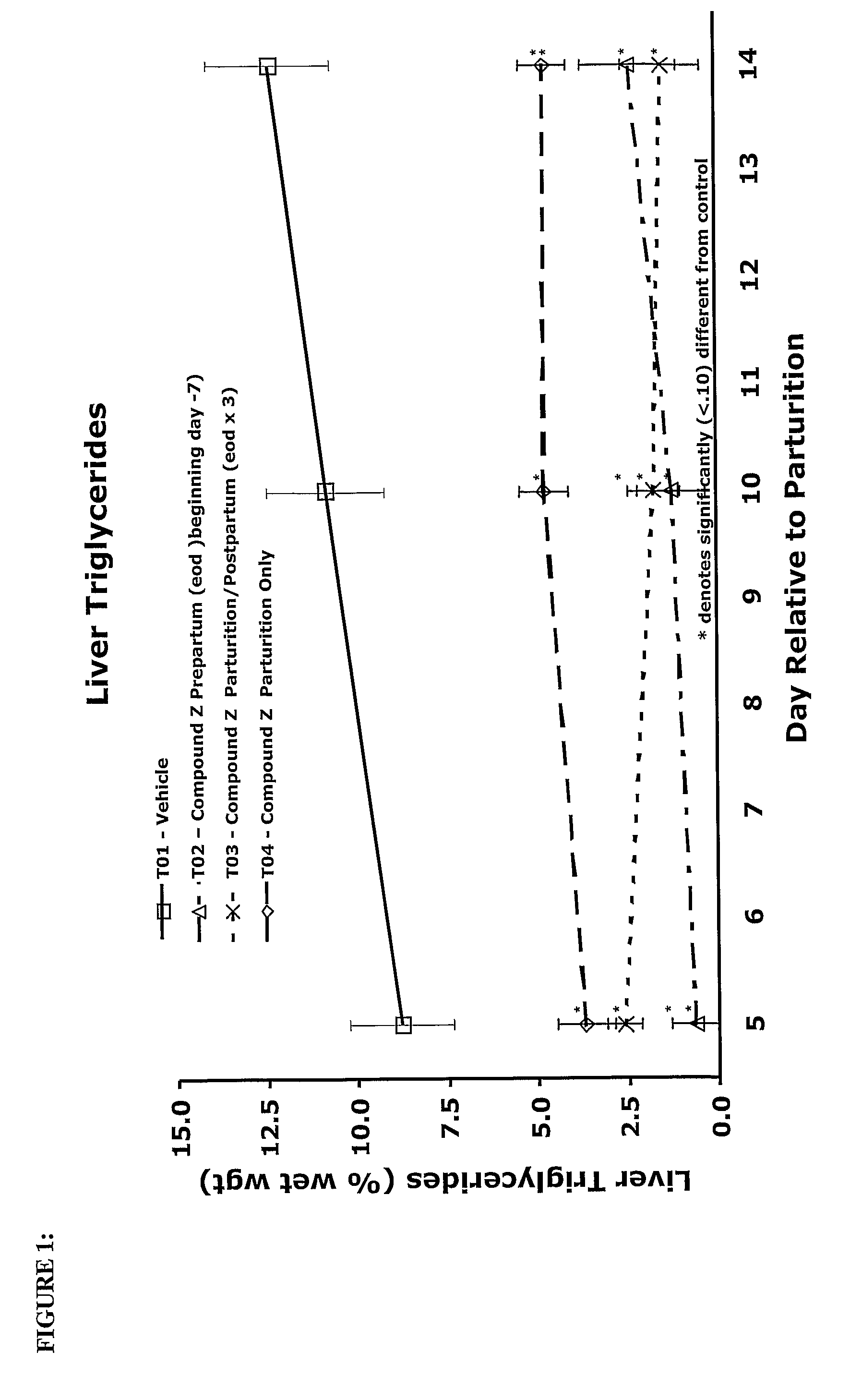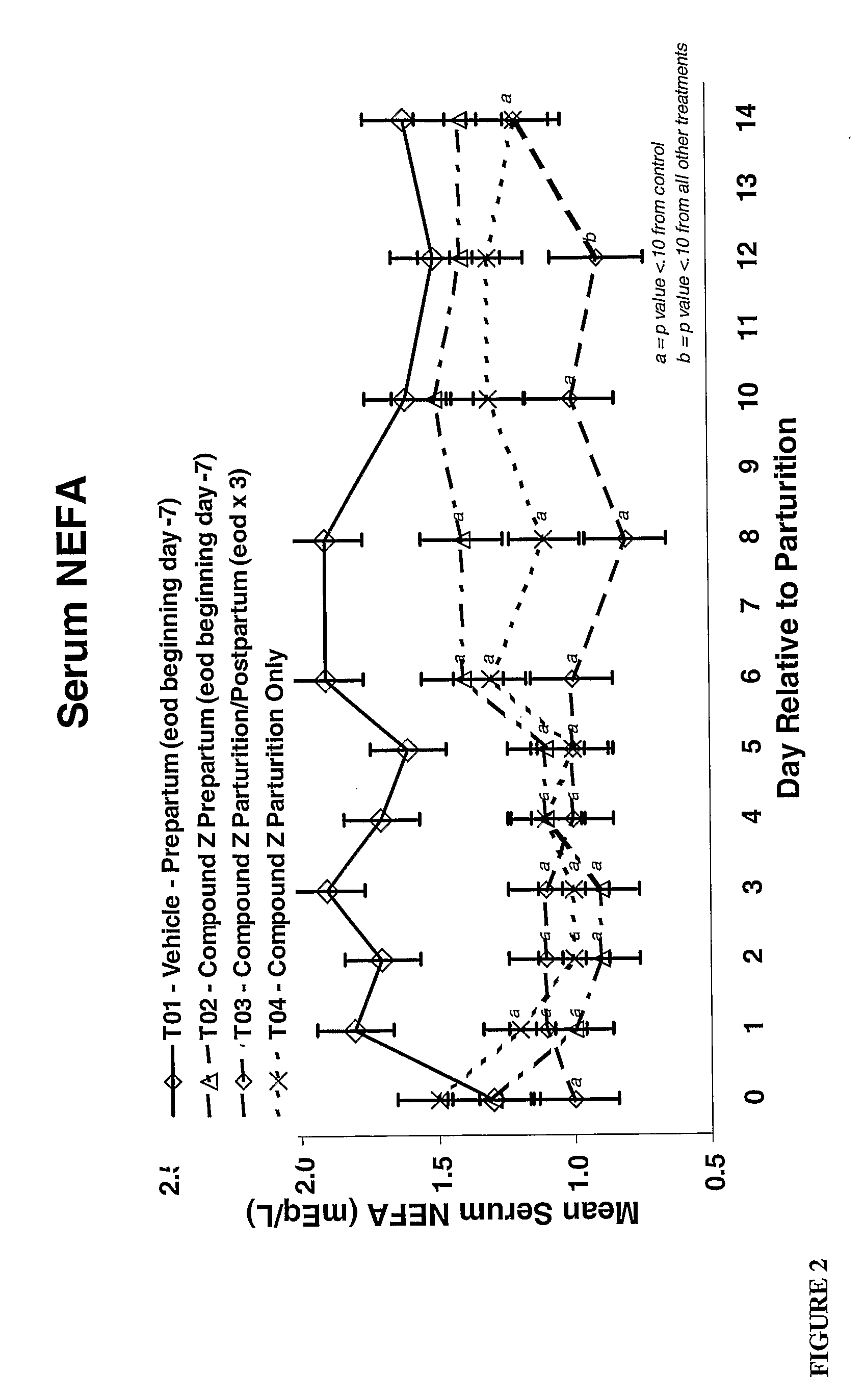Drugs And Prodrugs Useful The Treatment Of Energy Balance In Ruminants
a technology of prodrugs and ruminants, which is applied in the direction of anti-noxious agents, immunological disorders, metabolism disorders, etc., can solve the problems of reducing the ability of the liver to export triglycerides from the liver, affecting the energy balance of ruminants, and losing body condition and live weight, etc., to achieve the effect of reducing the levels of ketone bodies in ruminant milk, increasing milk quality and/or milk yield, and reducing the level of rumin
- Summary
- Abstract
- Description
- Claims
- Application Information
AI Technical Summary
Benefits of technology
Problems solved by technology
Method used
Image
Examples
formulation examples
[0236] In the formulations which follow, “active ingredient” means a compound used in the present invention.
Formulation 1: Gelatin Capsules
[0237] Hard gelatin capsules are prepared using the following:
IngredientQuantity (mg / capsule)Active ingredient0.25-100 Starch, NF 0-650Starch flowable powder0-50Silicone fluid 350 centistokes0-15
[0238] Formulation 2: Tablets—A Tablet Formulation is Prepared Using the Ingredients Below:
IngredientQuantity (mg / tablet)Active ingredient0.25-100 Cellulose, microcrystalline200-650 Silicon dioxide, fumed10-650Stearate acid5-15
[0239] The components are blended and compressed to form tablets.
[0240] Alternatively, tablets each containing 0.25-100 mg of active ingredients are made up as follows:
[0241] Formulation 3: Tablets
IngredientQuantity (mg / tablet)Active ingredient0.25-100Starch45Cellulose, microcrystalline35Polyvinylpyrrolidone (as 10% solution in water)4Sodium carboxymethyl cellulose4.5Magnesium stearate0.5Talc1
[0242] The active ingredients...
preparation 1
2-(Isoquinolin-7-yloxy)-2-methyl-propionic acid ethyl ester
[0253]
[0254] 7-Hydroxyisoquinoline (500 mg, 3.4 mmol), ethyl 2-bromoisobutyrate (3 g, 15 mmol) and potassium carbonate (2.1 g, 15 mmol) were mixed in 7 ml of anhydrous DMF. The reaction was heated to 95° C. under N2 for 18 hrs. The reaction was concentrated under reduced pressure and purified by flash column chromatography (33% EtOAc / Hexanes) to yield 470 mg (53%) of the title product of this preparation as a yellow oil.
[0255]1H NMR (400 MHz, CDCl3) δ 9.08 (s, 1H), 8.41 (d, 1H), 7.72 (d, 1H), 7.57 (d, 1H), 7.33 (dd, 1H), 7.13 (d, 1H), 4.25 (q, 2H), 1.69 (s, 6H), 1.22 (t, 3H).
preparation 2
2-(1,2,3,4,4a,8a-Hexahydro-isoquinolin-7-yloxy)-2-methyl-propionic acid ethyl ester
[0256]
[0257] The title product of Preparation 1 (470 mg, 1.8 mmol) and platinum oxide (21 mg, 0.09 mmol) were mixed in 10 ml glacial acetic acid, under 50 psi of H2 at room temperature for 18 hrs. The reaction was filtered though Celite and concentrated under reduced pressure. The residue was diluted with EtOAc and made basic with 1 N NaOH. The organic layer was separated and the aqueous phase was extracted with 3× EtOAc. The organic phases were combined, washed with brine, dried over Na2SO4, filtered and concentrated to yield 443 mg (93%) of the title product of this preparation as a yellow oil.
[0258]1H NMR (400 MHz, CDCl3) δ 6.94 (d, 1H), 6.63 (dd, 1H), 6.50 (d, 1H), 4.23 (q, 2H), 3.92 (s, 2H), 3.09 (t, 2H), 2.70 (t, 2H), 1.56 (s, 6H), 1.25 (t, 3H).
PUM
| Property | Measurement | Unit |
|---|---|---|
| Time | aaaaa | aaaaa |
| Time | aaaaa | aaaaa |
| Time | aaaaa | aaaaa |
Abstract
Description
Claims
Application Information
 Login to View More
Login to View More - R&D
- Intellectual Property
- Life Sciences
- Materials
- Tech Scout
- Unparalleled Data Quality
- Higher Quality Content
- 60% Fewer Hallucinations
Browse by: Latest US Patents, China's latest patents, Technical Efficacy Thesaurus, Application Domain, Technology Topic, Popular Technical Reports.
© 2025 PatSnap. All rights reserved.Legal|Privacy policy|Modern Slavery Act Transparency Statement|Sitemap|About US| Contact US: help@patsnap.com



